# Coffee Module One
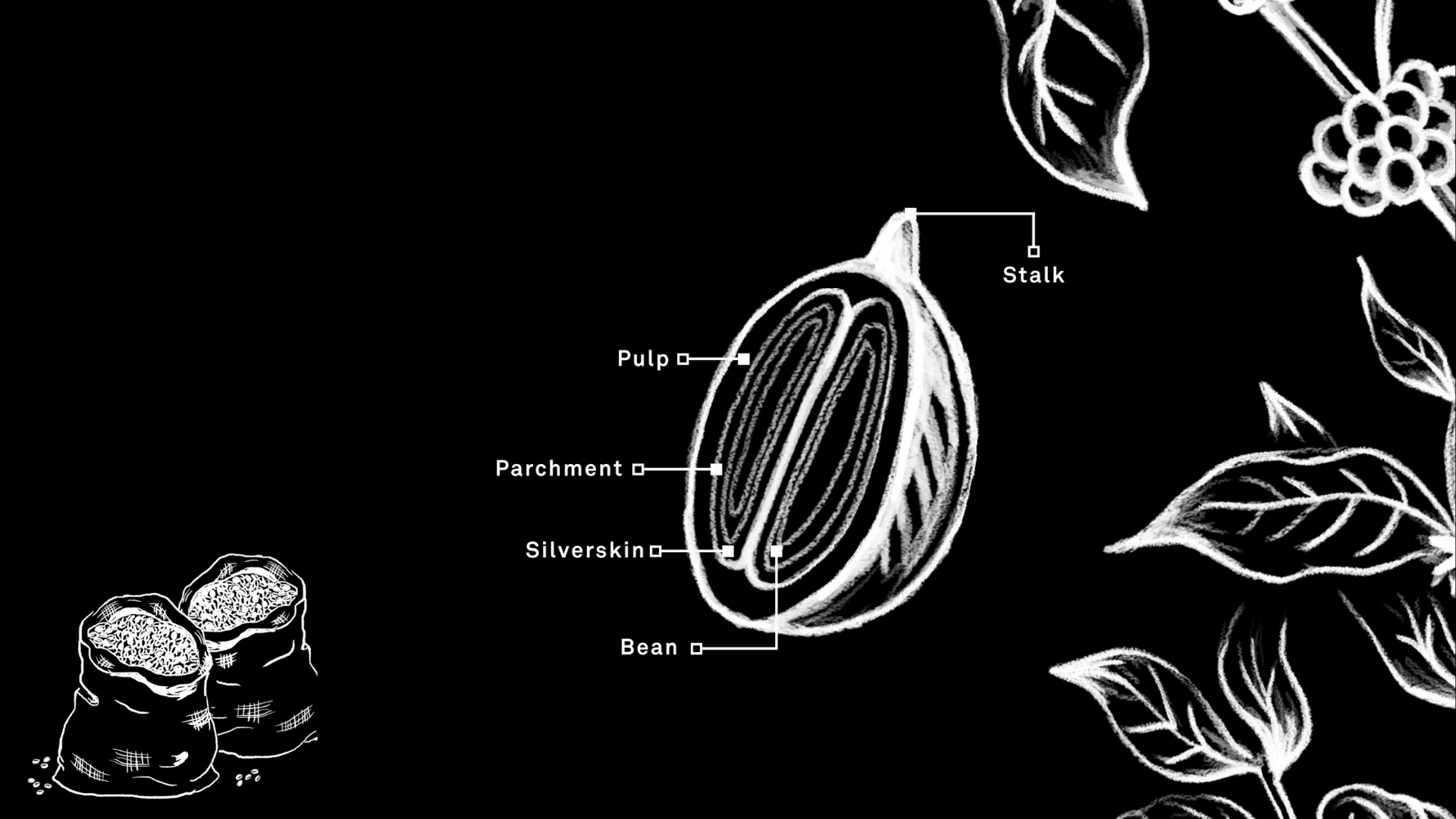
# What is Coffee?
COFFEE IS FROM A FRUIT.
In commercial coffee production there are two species of coffee used for consumption Arabica and Robusta.
At the moment we at Code Black only buy Arabica Green Beans (Unroasted Coffee) to roast as Arabica is known to be the higher quality out of the two, however the specialty coffee industry are experimenting trying to improve the quality of Robusta coffee and we could be purchasing Robusta in the future if they are up to standard.
Just like all fruits they range in varieties e.g. In wine there’s varietals of grapes like pinot noir, chardonnay, pinot gris.
Within the Arabica coffee species there are dozens of different known varieties e.g. Typica, Caturra, Catuai, Bourbon etc. Each variety will have different characteristics whether it be taste or aroma to production yield or disease resistance.
Just like all fruits, coffee naturally will contain acidity and sweetness. The toasty, nutty or roasted flavours only develop from roasting where sugars from coffee are caramelized; this is how we know the common taste of coffee. However, the darker the roast doesn’t mean the better the brew as this is a common misconception, for example take a nice piece of eye fillet steak we all prefer it to have a nice toasted flavour but we still want it cooked to a certain point eg, medium rare to showcase the quality of the meat and its natural flavour. Same with coffee, it should be roasted to a point where the preferred flavour profiles are highlighted generally between light to medium roast.
Coffee is a brewed beverage made from an extraction of roasted seeds from the cherries produced on a coffee plant, which is known as a coffee tree.
The coffea plant is native to subtropical African countries and some islands in southern Asia.
# What Is Specialty Coffee?
To put it simply specialty coffee is quality coffee.
Like the fine wine of coffee, where quality is maintained from seed to cup and having every stage of the beans life cared for, starting from the farmer also known as the producer who’s dedicated their lives into producing and focusing on quality not quantity.
At this stage only coffees that are free from defects and are at optimum ripeness will be passed on to the next hands in the chain.
It is from here where the farmer must be able to recognize that their coffee goes to like-minded people in the chain to ensure a higher profit.
The green processed coffee then goes to the green coffee buyer who is either certified as a coffee taster with a Q grader certification just like a certified sommelier or green buyers with great cupping/industry experience and knowledge, they will be able to determine the quality of the coffee and pricing of the product which is then determined if the coffee is deemed specialty or not.
For coffee to be labelled as specialty it needs to reach a score of over 80/100 when coffee gets cupped by industry professionals not always necessarily by Q graders.
Cupping is the industry method of tasting and assessing coffee quality similar to wine tasting.
The coffee is then sent to a roaster where the coffee is roasted to a specific degree to highlight the flavour profiles that are preferred. From here the barista recognizes that the coffee has gone through 3 stages of quality control and it is their job to brew the consumer a delicious coffee and minimize any loss of quality from the beans. The Barista cannot add quality to the coffee but instead tries to ensure that the brew is not compromised in the brewing process and the beans are used to their full potential in the final product.
And lastly the consumer finishes the final step in the specialty chain in recognizing and understanding the efforts and quality put into specialty coffee, as well as benefiting everyone who’s hands have touched the coffee.
# Cupping and Flavours
Coffee Cupping or Coffee Tasting is the practice of observing the taste and the aromatics of brewed coffee to identify its flavour.
Flavour in general is the combination of 30% taste and 70% aroma.
Cupping is an industry practice that can be done informally by anyone or with strict protocols and guidelines by Master Tasters also known as “Q Graders” to fully assess the coffee. It involves evaluating the coffee after roasting by grinding the beans and steeping it with hot water in cupping bowls after a set amount of time.
The ground coffee floats to the top forming a crust. By breaking the crust a cupper can evaluate the aromatics as they are released. The brew is then slurped from a cupping spoon aspirating the coffee over the palate to obtain the organoleptic (flavour) profile of each coffee.
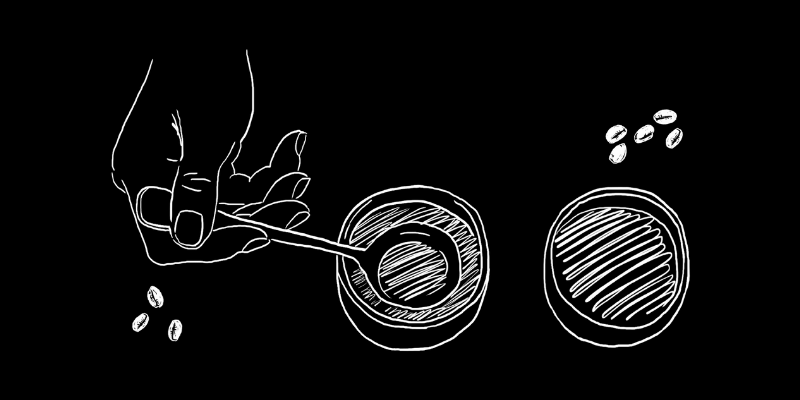
When cupping each coffee is evaluated by:
Fragrance/Aroma: fragrance of the dry grounds and aromas of the wet
Flavour: combined impression of all the gustatory sensation (taste buds) and retro nasal aromas from mouth to nose
Aftertaste: length of positive or negative flavour
Acidity: often referred to as ‘brightness’ or ‘sourness’
Body: tactile feeling of liquid in the mouth
Balance: how the various aspects of flavour, aftertaste, acidity and body work together or contrast each other
Uniformity: consistency of flavours within the same sample of coffee in different cups
Clean cup: lack of interfering negative impressions from ingestion to aftertaste
Sweetness: pleasing fullness of flavours mostly cause by certain carbohydrates
Defects: are negative or poor flavours that detract from the quality of the coffee
Overall: the overall scoring is meant to reflect the holistically integrated rating of a sample as perceived by the cupper
Like wine, coffee varies in flavour, taste and aroma due to numeral factors.
Some of things that impact coffee flavours are:
Variety: Different varieties of coffee will have specific taste characteristics
Terroir: Is the influence of where the coffee is grown. Some examples:
Altitude
Climate (temperature, moisture levels etc.)
Soil Type
Soil micro-biome (Microorganisms found in the soil)
Topography (Structure of the landscape)
Farming Practices: Everything from the use of particular chemicals to planting patterns & pruning regimen are ultimately are going to affect the nature of the crop.
Processing: The methods used to turn ripe coffee cherries into dried green beans the 3 most common processing methods for specialty coffee are:
Natural – Drying the seeds while still in the fruit
Washed – Drying the seeds without the fruit intact by using fermentation to separate the fruit
Honey – coffees are dried with some and not all of the outer layer of the coffee cherry removed
Roasting: By turning coffee from green beans to brown roasted coffee with heat we are changing the physical and chemical structure of the coffee, caramelizing sugars, adding roast flavours with Maillard reactions and other chemical reactions.
Brewing: is the final stage in the process from soil to palate, many variables come into play and could change how the coffee tastes. Some important variables are:
Brew Ratio (water to coffee)
Grind Size (and uniformity)
Extraction Time
Water Temperature
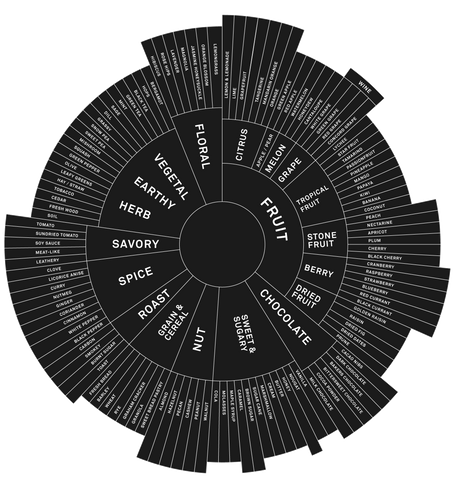

# Processing: An Intro
The term processing in specialty coffee refers to the methods and preparation used to turn fresh ripe coffee cherries into green beans (unroasted raw coffee cherry seeds)
Coffee beans must be removed from the fruit/cherry before they can be roasted, this can be done in several different ways however there are 3 more common methods used and have a huge impact on the flavour of the coffee:
Natural Processing
Refers to any one of several technological variations where the parchment and skin are dried together.
This where the whole cherries after harvest is cleaned and placed in the sun either on drying tables or thin layers on patios, the cherries are constantly being rotated by hand or with rakes to ensure even drying of the cherries, to reach the desired moisture content of 10 – 12 percent, depending on the region and strength of sun this process can take up to 4 weeks, however some producers have the option of mechanical drying to speed up the process.
Benefits: Because the fruit sugars are drying into the seeds of the green coffee, the results are a heavy bodied (heavy on palate) really sweet, fruity tasting coffees
Negatives: Has a high risk of over fermentation of the fruit during drying
Washed Processing
Refers to any one of several technological variations where the parchment and skin are removed/separated before drying.
In the wet/washed processing the cherries are sorted first by immersion in water where the bad/unripe cherries will float to the surface and the good cherries sink, from here the good cherries are then pulped (squeezing the seeds out of the cherry). At this stage the seeds will still have a large quantity of pulp and mucilage which needs to be removed, this can be done in 2 ways:
Ferment and Wash: the pulped seeds are placed in a fermentation tank to ferment away the fruit surrounding the seeds either in their own fruit juice or water, this fermentation can take from 24 -36 hours to complete.
Machine Assisted: the pulped seeds don’t require fermentation to remove the fruit flesh but instead machine scrubbing to scrub away the fruit substances from the seed.
The cleaned seeds are then dried on raised beds or thin patios in the sun to a desired moisture content.
Benefits:
Because the fruits not drying/fermenting into the seeds and is completely removed before drying, the results are a cleaner, acidic/brighter and light bodied coffee
**Negatives:**Very costly to produce, requires a lot of resources
Honey Processing (Pulp Natural)
Refers to any one of several technological variations where the parchment and a specific percentage mucilage (the fruit layer surrounding the parchment) are dried together with the seed and the skin/pulp removed.
The Honey process is the most difficult and demanding to execute well. The coffee is pulped then spread out to dry without washing, leaving some of the mucilage still attached to the beans, the beans are then spread very thinly on purposely built drying beds and turned hourly for up to 10 -15 days.
Depending on how much mucilage is still attached on the coffee seeds before drying determines what type of honey process it is:
- Black Honey – 100% Mucilage still attached
- Red Honey – 75% Mucilage still attached
- Yellow Honey – 50% Mucilage still attached
- Golden Honey – 25% Mucilage still attached
- White Honey – 0% Mucilage
Benefits: This method gives you the best of both worlds with the fine elegant attributes of washed coffees and the substantial body and fruit sweetness of a naturally processed coffee
Negatives: High risk of drying faults, intensive manual labour.
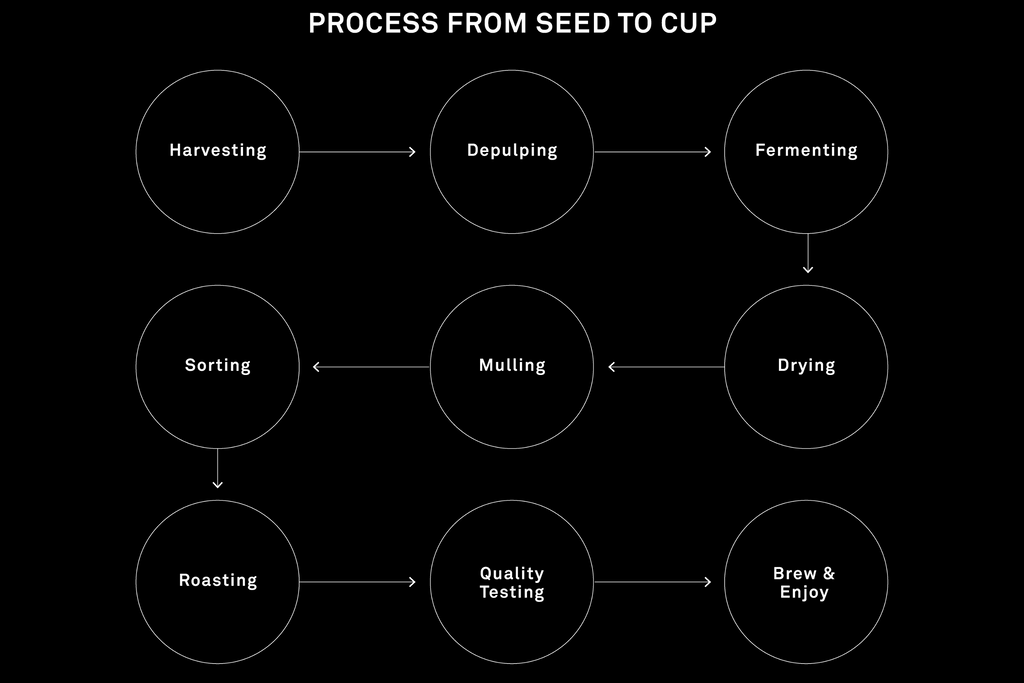
# Coffee Roasting (Intro)
We may be getting into more familiar territory here but that doesn’t mean that we shouldn’t reflect carefully on the impact of roast profile on flavour. Not even the best roaster can make poor quality green coffee taste great but an unskilled roaster can easily ruin a high graded lot.
A roaster needs to have a good understanding of coffee, its botany, production, chemistry, brewing techniques, growing regions, coffee tastes, its aromatic qualities and most importantly a feel for the roast, it’s a very sense driven craft requiring the use of smell, sound and sight.
Coffee is composed of organic oils, water, protein, starch and vitamins – all of which change during the roasting process. The coffee bean will lose approximately 10-16% of its weight during roast and its mass will increase up to 30%. On average our roasts take 12-17 min per batch.
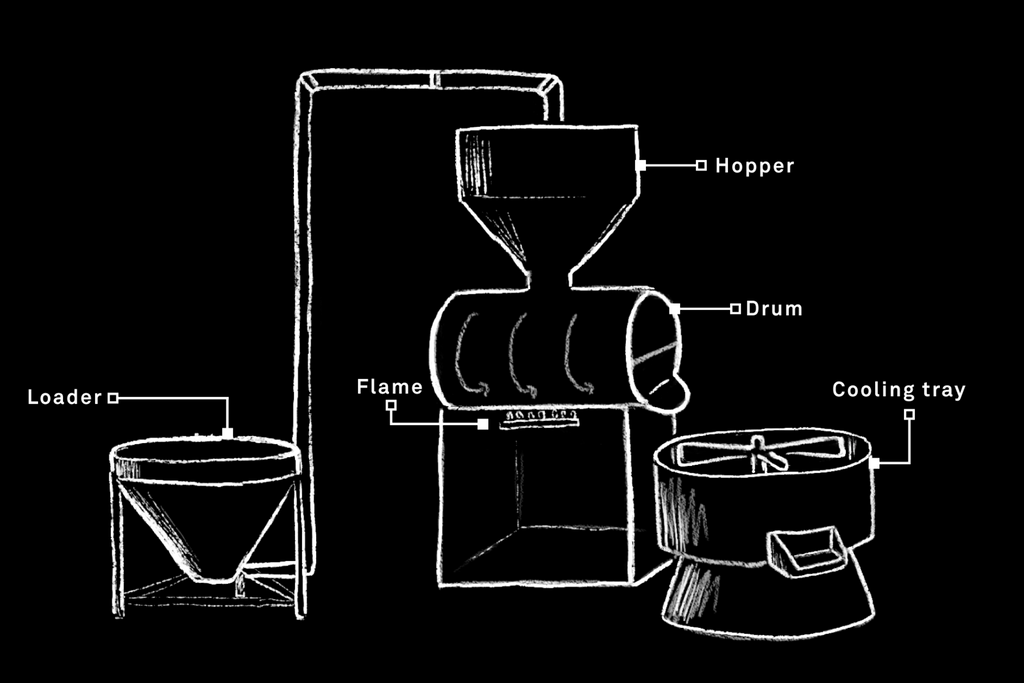
The coffee first goes through an endothermic reaction and is slowly turning yellow from green, at this stage its basically just dehydrating.
During roasting the cell walls of the bean expand and break as moisture evaporates from within and is released, the noise this reaction makes is called first crack. The roaster uses the cracking sound to indicate the stage of roast the coffee is in and will start to assess and sample the colour change of the beans, from here the coffee is going through what is called a Maillard reaction, basically it’s the chemical reaction between amino acids and sugar reduction that gives brown foods its own desirable flavour e.g. steak doesn’t taste like steak without Maillard, coffee doesn’t taste like coffee without going brown first.
Following this is sugar caramelisation of the natural sugars found in the coffee. Coffee when pushed further in roast can go into what is called a second crack where its hits pyrolysis and develops different types flavour, however at Code Black our coffees aren’t roasted that far as we try and stick into the ranges of light – medium (except for decaf) roast profiles to preserve as much of the natural flavour characteristics produced from its origin.
After sourcing and selection of green the roaster helps to realize the full potential of the coffee by carefully crafting a roast profile that will suit that set of beans. It’s not as easy as light or dark, as roast colour can be very misleading.
The Roaster has to fine tune variables like:
- Roast time: how long the beans are in contact with heat for
- Charge Temperature: temperature of the roaster before the beans go into the drums
- Rate of Rise: speed of the heat increase of the coffee as its roasting
- Drum Speed: speed of the rotation of the drums inside the roaster
- Air Flow: amount of air flowing through the roaster during a roast
- Cooling Speed: rate of cooling for coffee after roasting to room temperature
# Brew Methods
Essentially all coffee brewing methods involve using water to carry through (extract) flavour from dry grounds of coffee into a brew (water carrying coffee particles, solids).
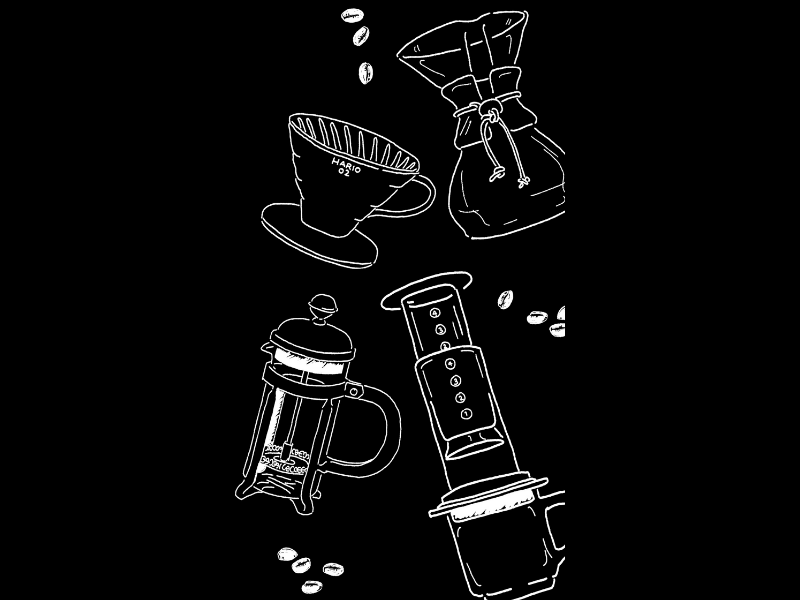
Different brew methods will give you different flavours, taste, aromatics, mouthfeel of the same coffee so it’s important to understand what brew method is right for what you’re looking to extract out of a coffee.
There are lots of different types of brewing gadgets and gears out there however most of them will lie under one of these brewing methods:
Pour-over or Filter Brews
In literal terms pouring water over dry grounds of coffee, this method of preparation all involves brewing by percolation meaning water is passed through a bed of coffee grounds extracting flavour as it passes through, usually with a filtration material to filter the groundsbefore the resulting brew. The filter can be anything from paper to different types of cloths to fine metal mesh, the different materials used for filtration will significantly impact the flavour of the brew especially mouthfeel.
Filter Brews with paper filters
Paper filters are the most common type of filter option as they produce the cleanest cup of coffee. They tend to filter out most of the super fine particles that other material tends to miss. Results are a clean, clear, crisp bodied coffee.
Filter Brews with cloth filters
The cloth filter has been used for a very long time but as time progressed less and less people are using it. If done correctly cloth filter brews can be delicious and just like the paper filter methods, it reduces the amount of finer particles passing through and into in the cup. Results are clean tasting coffees with a good amount of body.
The problem with cloth is that it is designed to be reused and is required to be maintained clean and dry otherwise it will leave tainted flavours.
Filter Brews with metal filters
Metal filters are quite a new filtration method designed to be clean and reusable, the mesh holes aren’t as fine as the holes in paper or cloth filters so it allows more oils and finer particles to pass through resulting in a brew with a lot more body and aromatics.
Problem is that it’s quite easy to over extract your coffee and could ruin your brew as the fines that have passed through the metal filter into your coffee continues to extract.
Full Immersion Brewing
A Brewing method where all the coffee grounds are fully submerged into a set volume of water over a period of time and then filtered out using a filtration material either paper, cloth or metal. The coffee and water are steeped together this promotes a more even contact with the grinds and water resulting in a more uniform extraction, because of this your brew will be bigger and richer bodied.
Pressurized brewing
Probably the most popular and common method of coffee brewing outside of home, most commonly known as “Espresso” essentially brewing coffee with applied pressure to extract coffee, this allows us extract a lot of flavours and characteristics out of a coffee that other brew methods cannot achieve, also doing it a lot faster than other brew methods.
This method still uses the percolation theory of water passing through a bed of coffee however done in a very volatile and intense pressure.
# Single Origin Vs Blends
Most of the coffee that the world drank a few decades ago was blended, while that’s still probably true across the coffee industry as a whole, in the specialty segment, Single Origins are becoming increasingly popular. This is mostly because it allows the consumer to experience the fruits of the coffee farmers labour (quite literally).
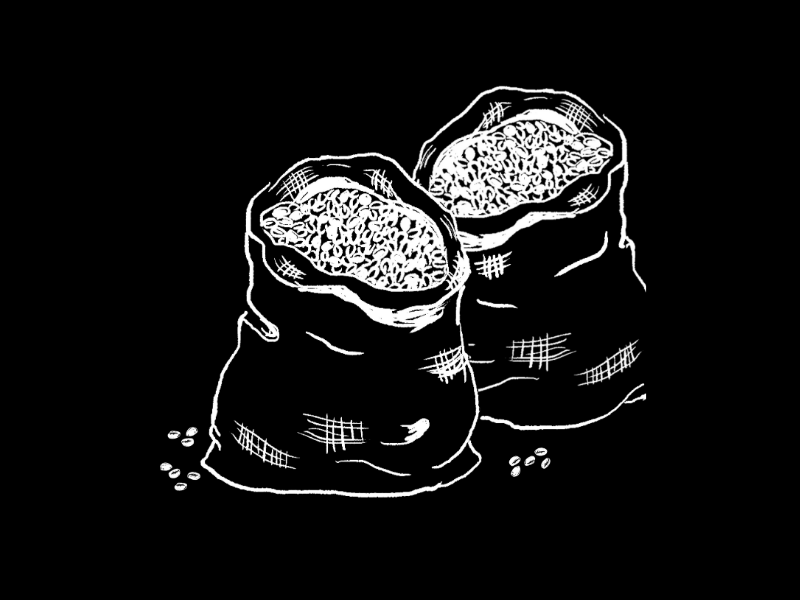
Nevertheless, blending can be a masterful craft in its own right. In its basic form it ensures a consistent flavour experience throughout the year as the parts/inputs of a particular blend will change due to seasonal availability, in saying that consistency of flavour will change but not entirely, however overtime it will be impossible to retain the same or similar flavour characteristics so that’s why it’s a lot more common now that we see blends being called seasonal blends that fully embrace the fact that consistency year round is impossible but rather create a blend utilizing flavours of coffee that is available to us at the time. At its best a blend can be a unique flavour experience, where the flavour is a lot more than just a sum of its component parts.
Single origins offerings are exciting and delicious!
There’s many reasons why we think that here at Code Black, one of reasons is that it allows us truly to appreciate all the flavours and nuances of the coffee from that one particular farm, or region, or cooperative or even one lot of coffee from a particular farm. We get to taste the hard work gone into the coffee and become more educated on how the terroir/ varietals or farming practices to name a few, have all helped us achieve this particular tasting coffee.
What’s great is that certain blends or single origins will taste better with different beverages some blends might taste great as a black coffee and some single origins might go great with milk or vice versa.